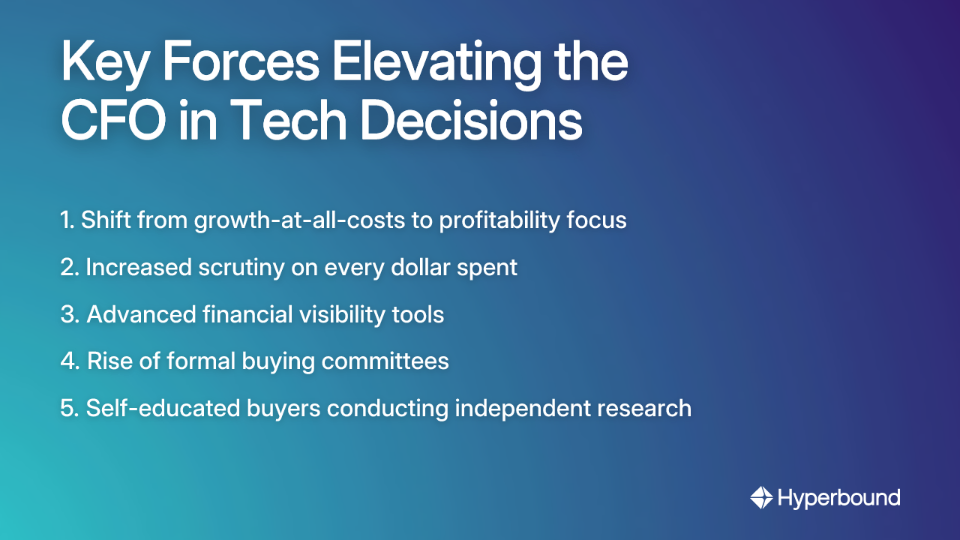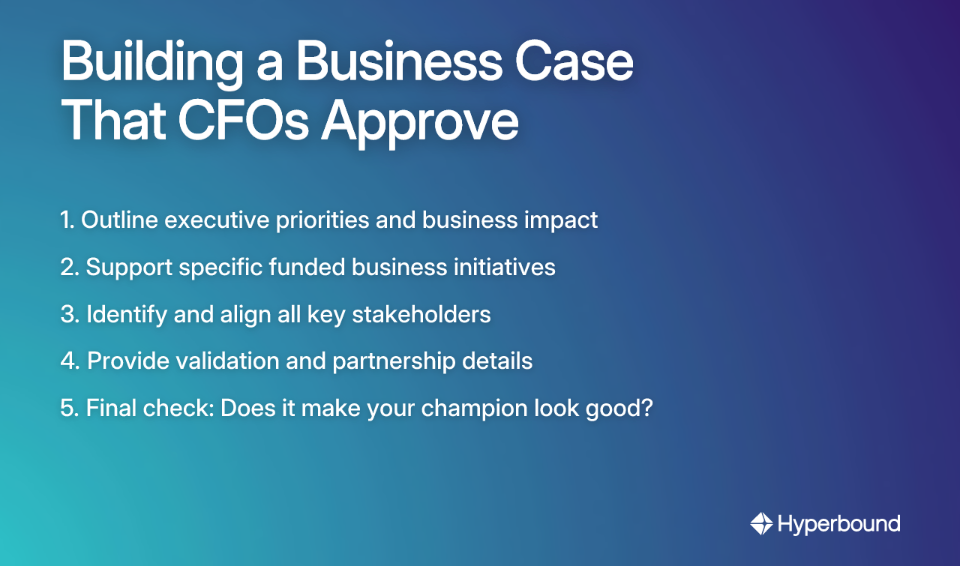
You've set up the perfect demo for your B2B software solution. Your technical features are polished, your UI is sleek, and you're ready to wow the IT team with your cutting-edge capabilities. But then comes the dreaded email: "Our CFO would like to join the next call to discuss ROI metrics and strategic alignment."
Suddenly, you're scrambling to translate your technical pitch into financial language, wondering how your carefully crafted presentation about system architecture and integration capabilities will resonate with someone whose primary concern is the bottom line.
Welcome to the new reality of B2B software sales, where the CFO has emerged as your most critical buyer.
The Ground Has Shifted Beneath Your Feet
The truth is stark and unavoidable: selling to pain is OVER. According to G2's Software Buyer Behavior Report, only 33% of buyers now consider IT as the final decision-maker—a significant 10% decline from just two years ago. Meanwhile, 26% now identify C-suite executives, particularly CFOs, as the ultimate authority on software purchases—a 7% increase in the same period.
This isn't a temporary trend or a market blip. It's a fundamental restructuring of how organizations make technology decisions. The economic buyer, personified by the CFO, is now your primary audience, and this shift is reshaping every aspect of the B2B software sales process.
Why Now? The Economic Forces Anointing the CFO as Tech Gatekeeper
Several powerful forces have converged to place financial leaders at the center of software purchasing decisions:

The End of Growth-at-All-Costs
The era of prioritizing growth above all else has ended. Economic pressures have forced a pivot toward efficiency and profitability. According to research from Bessemer Venture Partners, there's now a 2:1 ratio of importance between profitability and growth for software companies. This fundamental shift in priorities has naturally elevated the role of financial stewards.
Intensified Cost Scrutiny
In today's economic climate, every dollar is under the microscope. While 55.6% of buyers expect software spending to increase, these purchases are subject to unprecedented levels of justification. CFOs now wield significant power to control expenditures and are scrutinizing all purchases, especially in categories like ERP systems, CRM platforms, and Cloud Infrastructure where spending has traditionally been substantial.
The Rise of Financial Visibility Tools
Modern spend management platforms have given CFOs unprecedented visibility into departmental spending. Financial Software and AI-powered Analytics now allow finance teams to track every dollar spent on technology, enforce compliance, and prevent software sprawl across the organization.
The New Buying Reality: It's a Committee, Not a Conversation
Today's B2B software buying process is no longer a simple conversation with a single decision-maker. It has evolved into a complex dance involving multiple stakeholders with diverse priorities:
The Rise of Buying Committees
A staggering 80% of companies now use formal buying committees to influence technology decisions, involving as many as 22 distinct roles from different departments. As one sales professional noted on Reddit, "Deals don't move forward just because one person is convinced. The entire group needs to be nudged toward a decision."
This committee-based approach creates several challenges:
- Longer Sales Cycles: With more stakeholders involved, reaching consensus takes significantly more time.
- Multi-threaded Sales Approaches: Sales teams must simultaneously engage multiple decision-makers with different priorities.
- Consensus is Critical: Nearly 80% of final decisions are consensus-based rather than dictated by a single authority.
The Self-Educated Buyer
Perhaps most concerning for sales teams, 68% of B2B buyers only involve a vendor's sales team at the final stage of their decision process. Today's buyers conduct extensive research independently, meaning your online presence, educational content, and reputation are critical for building internal champions before you even get a call.
Translating Tech Value into Financial Language
To succeed in this new landscape, sales professionals must fundamentally shift how they communicate value. When speaking with financial decision-makers about solutions like Cybersecurity, Compliance Software, or Identity Protection Software, remember that most "high-level execs tend to be direct to the point of rudeness—they don't have time for BS, so cut to the chase immediately."
The CFO's Core Questions
Before approving any purchase of Warehouse Management Software (WMS), Data Center Infrastructure, or Telephony and Communication Software, CFOs will interrogate every proposal with these questions:
- Do we really need this tool? How can you quantify the efficiency gains or revenue impact? Is this purchase aligned with our strategic initiatives and already in the budget?
- Why this vendor? Can we consolidate existing tools? Does this vendor offer better terms than our current providers?
- What are the hidden costs? What is the total cost of ownership (TCO), including implementation time, training, and potential upgrade fees for Project Management Tools or Automation Tools?
- How does the pricing model work? CFOs are skeptical of unpredictable costs in usage-based models and concerned about paying for unused "shelfware" in seat-based models, particularly with fluctuating headcounts.
From Features to Outcomes
The old sales motion focused on technical features and benefits. The new approach must emphasize business outcomes and financial metrics:
Old Pitch (to IT): "Our Point of Sale (POS) System integrates with your existing stack and automates checkout with our patented one-click technology."
New Pitch (for the CFO): "By implementing our POS System, you can reduce transaction processing time by 35%, allowing you to serve 15% more customers during peak hours. Our clients typically see a 250% ROI within 9 months, with a 12% increase in average transaction value through our upsell features."
Your New Playbook: Building the CFO-Proof Business Case
The business case has become the cornerstone of successful B2B software sales. As one project manager noted on Reddit, "The primary point of a business case is to get sponsor buy-in to fund the product." Without a proper business case, securing funding is nearly impossible—especially for significant investments in ERP, CRM, or sales enablement platforms. Equipping your team to build and present these cases effectively is crucial, which is where AI sales coaching platforms like Hyperbound come in, allowing reps to practice and perfect their financial-focused pitch.

Step-by-Step Guide to Building a CFO-Ready Business Case
Based on best practices from InAccord, here's how to create a business case that will resonate with financial decision-makers:

- Outline Executive Priorities
- Clearly state the buyer's high-level company goals and challenges
- Answer: Does this solution address a top executive priority? What is the business impact of the current pain points? Why is a solution needed now?
- Support Specific Business Initiatives
- Identify the specific, funded initiative your solution supports
- Articulate quantifiable outcomes: "This CRM will increase lead conversion by 10% and reduce customer acquisition costs by 15%"
- Identify and Align Key Stakeholders
- Name every critical stakeholder in the buying committee (economic buyer, technical buyer, end-users, champion)
- Ensure all stakeholders have access to essential resources like demo recordings, case studies, and security documentation
- Provide Validation and Partnership Details
- Include details on validation methods (e.g., proof of concept results)
- Outline alternatives that were considered and why your solution prevailed
- Present clear partnership terms (pricing, scope, contract length)
- The Final Check (Collaborate with your champion)
- Does this business case make our champion look good?
- Does it proactively address executive concerns?
- Is the language focused on their goals, not our features?
Positioning and Scripts: How to Engage the C-Suite
When engaging financial stakeholders about Data Center Infrastructure, Automation Tools, or Cloud Infrastructure solutions, your approach must be fundamentally different than when selling to technical users:
Equip Your Champion
Your primary job is to help your internal champion build credibility and present a well-researched case. Trust is key; CFOs are more likely to approve purchases if they trust the internal buyer's due diligence.
Positioning Strategy
Frame discussions around solving overarching business challenges, not just departmental pain points. When presenting Cybersecurity or Compliance Software, connect it directly to business risk mitigation and regulatory requirements, not just technical vulnerabilities.
Navigating Contract Negotiations
- Be flexible on contract length: Don't push hard for multi-year deals unless the value is undeniable
- Eliminate auto-renewal clauses: CFOs want control over renewals
- Expect shorter payment terms: With rising interest rates, CFOs want to hold onto cash longer
Post-Sale is the New Pre-Sale
Upon renewal, the CFO will assess actual benefits versus anticipated outcomes and scrutinize utilization rates for sales enablement and project management tools. Ensuring your customer success and account management teams can effectively communicate this value is critical for securing renewals. Platforms like Hyperbound's AI Post-Sales Roleplays help these teams practice navigating tough renewal conversations and proactively demonstrating ROI.
Thriving in the Age of the Economic Buyer
The CFO's role as a key decision-maker in tech acquisition is here to stay. This shift demands that sales professionals develop new skills:
- Financial Acumen: You must speak the language of ROI, TCO, and strategic value when selling AI-powered Analytics or Financial Software
- Consensus Building: Success depends on navigating complex buying committees and aligning all stakeholders
- Business Case Mastery: It's not enough to just build a business case; your team must be able to present it compellingly. This requires practice, a key component of modern AI sales coaching.
The B2B software landscape has fundamentally changed. Those who master the art of selling to the CFO will not only survive but thrive, building stronger, more strategic partnerships with their customers. In this new reality, your ability to translate technical capabilities into business value isn't just a nice-to-have skill—it's the difference between closed deals and lost opportunities.
The days of selling to IT alone are over. The CFO is your new buyer. Adapt accordingly.
Frequently Asked Questions
Why is the CFO now a critical buyer in B2B software sales?
The CFO has become a critical buyer due to a major business shift from a "growth-at-all-costs" mindset to a focus on profitability and efficiency. This change, driven by economic pressures, means every dollar spent is under intense scrutiny. CFOs now use advanced financial visibility tools to control spending and ensure every software purchase delivers a clear, quantifiable return on investment.
How do I translate technical features into financial benefits for a CFO?
You can translate technical features into financial benefits by focusing on business outcomes instead of product capabilities. Instead of describing what your software does, explain what results it produces. For example, rather than saying a feature "automates checkout," say it "reduces transaction time by 35%, increasing peak hour customer capacity by 15% and delivering a 250% ROI within nine months."
What are the key questions a CFO will ask about a software purchase?
A CFO will typically interrogate a software proposal with four core questions:
- Do we really need this? (Is it a strategic priority with a clear impact?)
- Why this vendor? (Is this the most cost-effective solution or can we consolidate existing tools?)
- What are the hidden costs? (What is the Total Cost of Ownership, including training and implementation?)
- How does the pricing work? (Is the model predictable and are we paying for unused capacity?)
What should a CFO-ready business case include?
A strong, CFO-ready business case justifies the purchase in clear financial terms and should include five key elements:
- Executive Priorities: How the solution addresses top-level company goals.
- Specific Initiatives: How it supports a specific, funded project.
- Stakeholder Alignment: A list of all key buyers and their roles.
- Validation and Terms: Proof of concept results and clear contract details.
- Champion Enablement: A narrative that makes your internal champion look good for bringing the proposal forward.
How has the B2B buying process changed with the CFO's involvement?
The B2B buying process has become longer and more complex. Instead of selling to a single IT decision-maker, sales now involve formal buying committees of up to 22 people. This requires a multi-threaded sales approach to build consensus among diverse stakeholders. Furthermore, buyers are now highly self-educated, conducting most of their research independently before even contacting a sales representative.
What skills do sales teams need to sell effectively to the CFO?
To sell effectively in this new landscape, sales teams need to develop three core skills:
- Financial Acumen: The ability to speak the language of business, including ROI, TCO, and cash flow.
- Consensus Building: The skill to navigate complex buying committees and align different stakeholders around a common goal.
- Business Case Mastery: The capability to create and present a compelling, data-driven business case that proves financial value.
Book a demo with Hyperbound
.png)













